Convertoplane Curtiss-Wright X-19 (USA)
The original projects were based on an effect discovered by scientists led by Henry Borst. Experts have found that when the propeller is moved from horizontal to vertical, a certain increase in lift is observed. At the same time, air resistance also increased, but the existing increase in lifting force completely compensated for it. This phenomenon was called the Radial force principle and was recommended for use in new projects, within which it was possible to improve certain characteristics. aviation techniques.
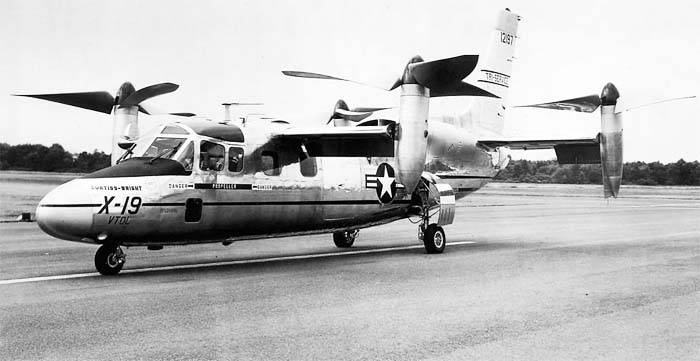
General view of an experienced convertible X-19
At the end of 1957, Curtiss-Wright decided to develop a new project using “radial force”. As an experiment, it was planned to develop and build a light experienced aircraft-convertiplane with the required characteristics. Having experienced such a machine and received positive results, the company-developer could continue to develop new technologies in the framework of other projects. Now we could talk about aircraft, initially suitable for practical use in one capacity or another.
Ground tests of the experimental convertible X-100 started at the beginning of 1959. Later, tethered flights and ascents into the air began without any insurance. Flight tests continued until mid-autumn 1961, when the only available prototype fell from a small height and was damaged. The car was restored, but not returned to the tests. By this time, it was decided to create a new project. All the forces of the Curtiss-Wright design bureau were devoted to the development of the next aircraft, based on original ideas.
The prototype X-100 was originally developed as a flying laboratory, necessary for testing a new technology. Already during the first tests, this machine confirmed the fundamental possibility of using the Radial force principle, which made it possible to start designing a new aircraft. By the end of 1961, the Curtiss-Wright engineers determined the technical appearance of the prospective machine and began to develop a complete project.
The new project, continuing the "tradition" of the name, received the designation X-200. In addition, the working designation Model 200 was used. Shortly after the start of design, Curtiss-Wright was able to interest a potential customer. The proposed machine could be of some interest to the armed forces, thanks to which the developers managed to get financial support from the Pentagon. The US military at that time showed great interest in aircraft of non-traditional schemes and supported the development of new similar projects. After receiving official support, the X-200 project was renamed X-19. Under this name the tiltrotor subsequently became widely known.
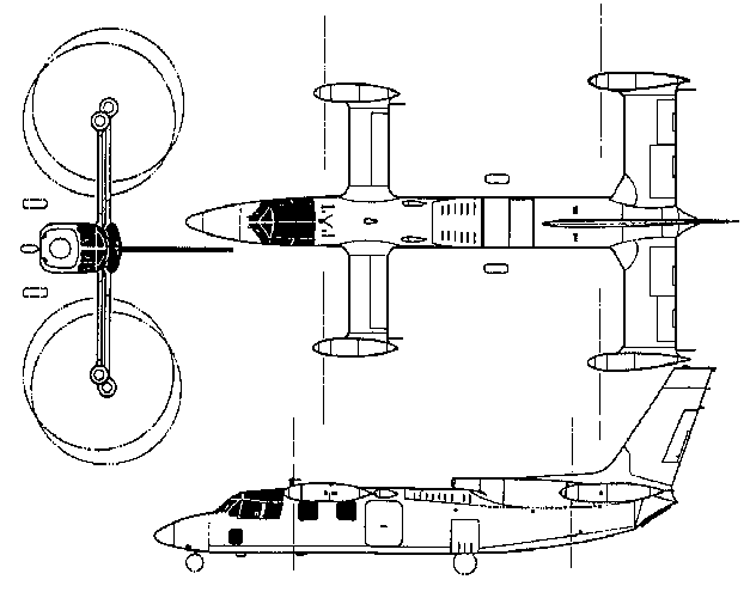
Machine layout
The new aircraft was created taking into account the future use of the army or civilian structures. For this, he had to have a number of characteristics. It was also proposed to revise the architecture of the structure, previously used in the project X-100. For example, in order to improve some parameters, it was proposed to change the number of rotors and rework control systems. To solve the problems posed, we had to use a fuselage similar to that of an aircraft. It should have been placed several planes with the original means of lifting into the air.
For the transport of passengers or cargo, the X-200 / X-19 convertoplane needed an appropriately sized fuselage. Its use led to the need to change the aerodynamic configuration and the use of two pairs of rotors. As a result, the use of layout developments was excluded from the previous project. A significant number of components and assemblies had to be re-designed and specifically for the new aircraft. At a certain stage of the project, this led to noticeable problems.
The new convertiplane received a long fuselage, a significant part of the volume of which was given to the pilot and cargo-passenger cabins. The fuselage had an all-metal frame-based design. The fuselage received a nose cone of rounded shapes, smoothly turning into a large and long central compartment of elliptical section. In the tail section, the fuselage section was changed: its lower surface rose, while additional large fairings were placed on the top and on the sides.
The layout of the fuselage was quite simple. A part of the necessary equipment was placed in the nose fairing; behind this compartment were pilots' workplaces. Behind the cockpit a volume was provided for passengers or cargo. Next in the fuselage was a small compartment with a variety of equipment, behind which was placed the power plant and part of the transmission elements.
The X-19 convertoplane was not equipped with traditional-shaped carrier planes. Instead, it was proposed to use high-placed wings of small width. The wingspan was determined in accordance with the size of the propellers. One such wing was located next to the passenger cabin, the second - at the front of the keel. The wings were equipped with tips, made in the form of large gondolas with equipment for mounting propellers. Gondolas could rotate around a horizontal axis, changing the position of the screws.
The tail of the traditional design was absent. There was a keel with a rudder, and the functions of the stabilizer were assigned to the rear wing. At the same time, elevators were placed on it, which were necessary for controlling the device in horizontal flight. On transient conditions and during vertical takeoff / landing, it was planned to use other means of control.
In the tail section of the fuselage, under large skirts, two Avto Lycoming T55-L-5 turboshaft engines with an 2200 horsepower XNUMX each were placed side by side. each. Air to the engines came through two intakes located above the surface of the fuselage. Exhaust gases were discharged through the tail nozzle. Next to the engines was placed the main gearbox, allowing the use of both motors, and each of them with the second off. The main gearbox provided for the issuance of torque to the two shaft, passing through the tail wing. In addition, it was connected with the longitudinal shaft, reaching the common gearbox of the front screws. The gondolas had their own gearboxes, which allowed the propellers to rotate in all flight modes and regardless of their position in space.
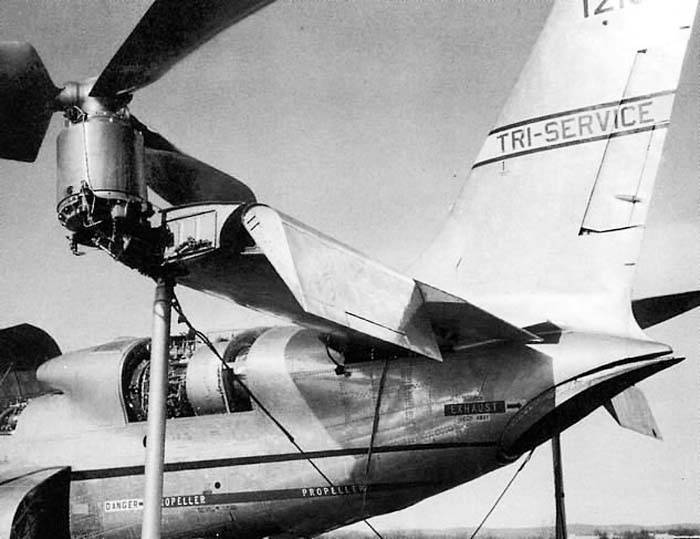
Fuselage tail section, engines, fender and propeller
In the framework of the previous project, the original design of propellers was tested in practice, which made it possible to maximize the potential of the “radial force”. Screws with a diameter of 3,96 m received special-shaped blades with a wide root part, tapering toward the tip. In addition, promising materials were again used: the blade had a metal spar and fiberglass sheeting, between which there was a cellular aggregate. Each screw had three similar blades mounted on a sleeve with a swashplate.
Given the possible use in practice, the promising machine immediately received a full-fledged chassis that complies with generally accepted standards and attitudes. A retractable three-point chassis with a nose strut was used. After takeoff, the front pillar, equipped with a small-diameter wheel, could retract into the niche of the nose fairing. The main racks were located in the rear fuselage and were removed by turning inward. At the same time, the rectangular section of the fuselage skin served as the side flap of the landing gear hatch.
To control the convertiplane X-19 was a crew of two people. Both pilots were placed side by side in the front cockpit. The project envisaged the use of a large glass area, providing a good overview of the front hemisphere, including upwards and sideways. Pilot workplaces were equipped with control knobs necessary to control the operation of control surfaces and four skew automatics. In addition, controls were provided for changing the position of propellers.
According to the experience of testing the experimental apparatus X-100, it was decided to change the control system. With vertical flight with the horizontal position of the propellers, control should be exercised only by changing their pitch. The gas rudders used in the previous project proved to be not the best, which is why the designers Curtiss-Wright decided to use other control systems. A synchronized or differential pitch change of the four screws allowed for roll, pitch and yaw control. After moving to level flight, turning the screws, the tiltrotor should have been controlled with the help of the rudders of the rear wing and keel.
Taking into account the possible use for one purpose or another, the authors of the new project placed in the fuselage a cabin suitable for transporting people or goods. The size of the cabin allowed to accommodate four passengers or a load of equivalent weight. Access to the cargo and passenger cabin was carried out through side doors. Passengers could observe the surrounding space with the help of onboard portholes.
The total length of the X-200 / X-19 aircraft was 13,5 m, the wingspan was 10,5 m. An empty convertiplane weighed 15 tons, with maximum fuel reserves and payloads - 5,2 tons. The existing power plant and four screws were to provide a vertical take-off and landing, regardless of weight. Maximum speed was set at 14,4 km / h, cruising - 4,4 km / h. The practical range, according to calculations, was to reach 6,2 km.
The technical appearance and design allowed the prospective car to solve a wide range of various military and civilian tasks. The possibility of high-speed horizontal flight with vertical take-off or landing gave noticeable advantages both over existing aircraft and helicopters. All of them could be implemented in one capacity or another.
First of all, the serial X-19 could perform the functions of light transport vehicles, competing with some existing helicopters. Army transport convertiplanes could also become carriers of machine gun weapons to support ground units. Transport vehicles could receive special equipment of one kind or another. First of all, they could find application in the role of tactical reconnaissance, having received special cameras. In general, the range of possible modifications was limited only by the needs and fantasy of the customer.
In the 1963 year, after receiving financial and other support from the military department, Curtiss-Wright began construction of two experienced convertitoplans at once. At the same time, the company's specialists had to face a number of serious problems. Even at the project development stage, it became clear that some important components, such as gearboxes with the required characteristics, etc. already exist, but still not worked out and put the project at risk. Nevertheless, the desire to outstrip competitors in conjunction with the correct approaches to work allowed us to a certain extent to reduce both risks and fears.
In the fall of 1963, the first prototype of the Curtiss-Wright X-19 came to the test. Checks began with ground tests, after which it became possible to carry out leash operations. 20 in November of the same year, the prototype for the first time off the ground, confirming the possibility of vertical take-off and landing. However, by this time some deficiencies of the technique in its present form were identified. There were regular problems with the gearbox of the same propeller. In addition, it was observed that the used turboshaft engines have insufficient acceleration. In some situations, this made it difficult to control the machine, and in other cases it could lead to an accident.
Checking the available prototype and studying its features, the specialists of the development company for some time worked on eliminating design flaws. Replaced were exposed as broken parts, and entire units. All this allowed to save the car from problems, but at the same time led to a serious delay in work. So, it was only possible to start testing vehicles on transient conditions in the summer of 1965.
25 August 1965, the first experienced X-19 took off again in a “helicopter” manner. Having driven the car to the required height and starting to move forward, the test pilot had to move the propellers to the pulling position. Even before the turnaround of the nacelles, one of the gearboxes crashed. The pilot was unable to take the necessary measures, as a result of which the prototype fell from a small height and crashed. Fortunately, the crew managed to leave the falling car and was not injured.
During the crash, the first prototype convertiplane was not completely destroyed, but still received serious damage. Repair and restoration of the car was considered inexpedient, including due to the completion of the construction of the second prototype. In the case of obtaining the appropriate solution, Curtiss-Wright was going to complete the assembly of the second prototype and bring it to the test instead of the lost first. However, this car did not manage to get to the airfield and rise into the air.
Recall that the X-200 project started as an initiative development and only after that was offered to the military department. The management of the company-developer managed to convince the Pentagon of the need for further work and to obtain the required support. The military showed the desired enthusiasm and began to consider the X-200 / X-19 convertiplane as a possible means of updating the fleet of aircraft. However, over time, the attitude of the Ministry of Defense to this project began to change.
In case of successful completion of work, the X-19 project allowed the army to get a new multi-purpose aircraft with sufficiently high performance and unusual capabilities, which has certain advantages over existing aircraft and helicopters. However, obtaining such results was associated with a lot of difficulties. During the tests, it was found that, in its current form, the proposed aircraft is quite difficult to manufacture and operate. In addition, he had noticeable flaws, the elimination of which required an indefinite time.
On the timing of completion of the work could only guess. The first flight on a leash was completed at the end of the autumn 1963 of the year, but due to further refinements, the dates for the start of new test phases were repeatedly shifted. The first attempt to test X-19 on transient conditions took place only in August and 1965 ended in an accident. Thus, the subsequent work again required to spend too much time. By this time, the military had time to lose enthusiasm, and the crash of the prototype in the next flight actually determined the fate of the once interesting project.
At the beginning of autumn 1965, the Pentagon decided on the future of the X-19 project. Due to objective problems and the impossibility of completing the work within a reasonable time, the military decided to abandon the further development of this vehicle. The project is officially closed. The study of the problems of vertical take-off and landing apparatus was decided to continue in other projects.
The first prototype of the convertible X-19, crashed in August 1965, decided not to recover. The remains of the car collected from the airfield and sent to scrap. The unfinished second prototype, no longer needed, was disassembled, depriving parts of the already installed equipment. He was later transferred to the National Museum of the US Air Force (Wright-Patterson Air Base, Dayton, PCs Ohio). As far as we know, a unique model of aviation technology still remains in the museum, although it is not in the best condition.
The project of a promising multi-purpose aircraft was closed due to dubious prospects and the impossibility of completing all the required work at an acceptable time. The armed forces were deprived of the opportunity to get a promising machine capable of solving a wide range of tasks, but at the same time they got rid of the unsuccessful project, which was wasting money and time without noticeable returns. For Curtiss-Wright, the closing of the X-200 / X-19 project was another blow. Having suffered another setback in the creation of new aircraft, she was forced again to leave the aviation industry.
On the materials of the sites:
http://airwar.ru/
https://airandspace.si.edu/
https://crgis.ndc.nasa.gov/
http://dogswar.ru/
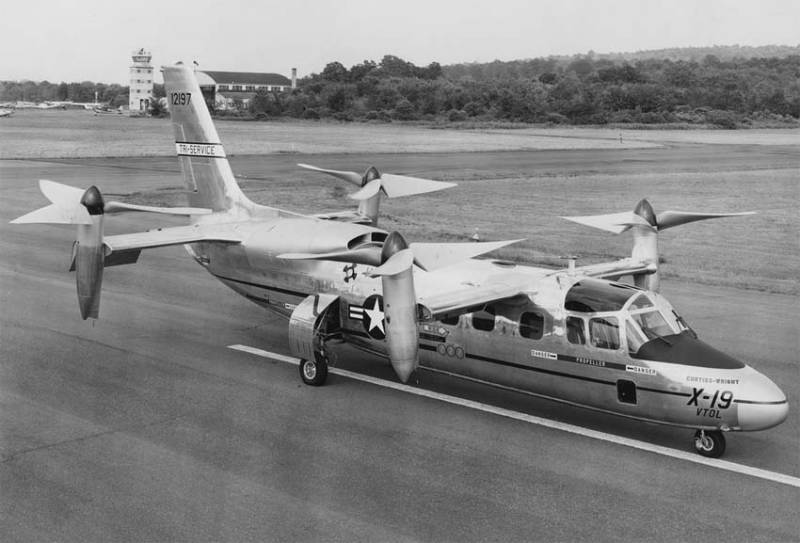
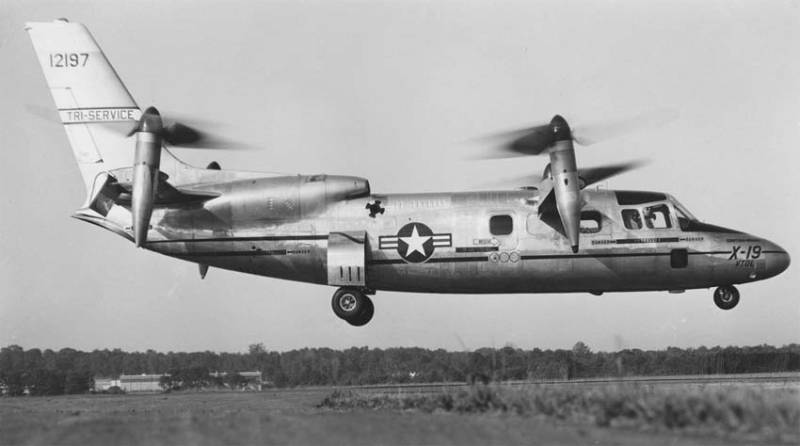
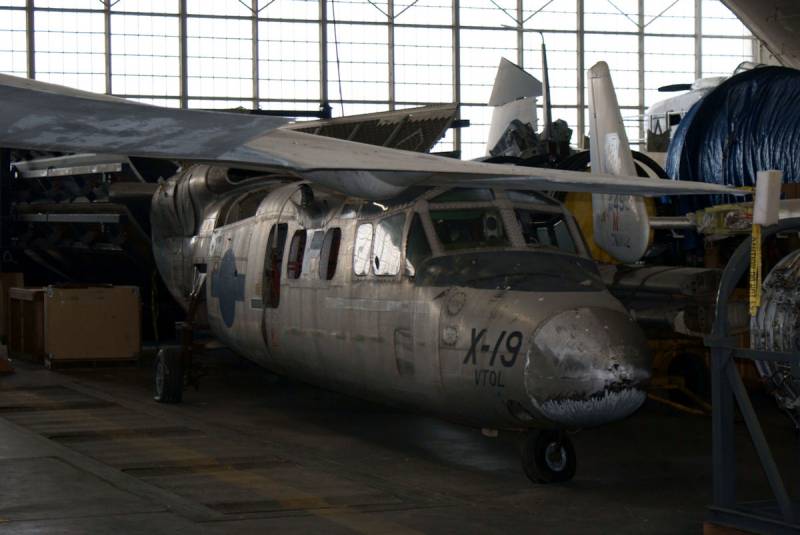
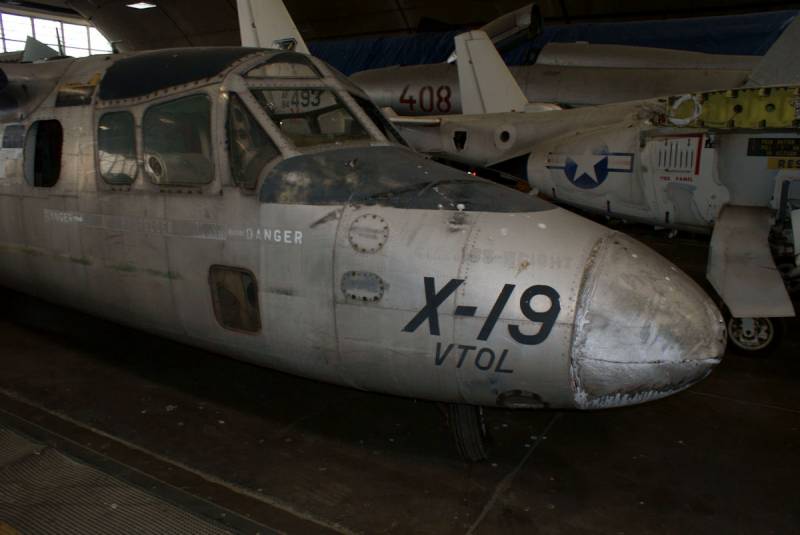
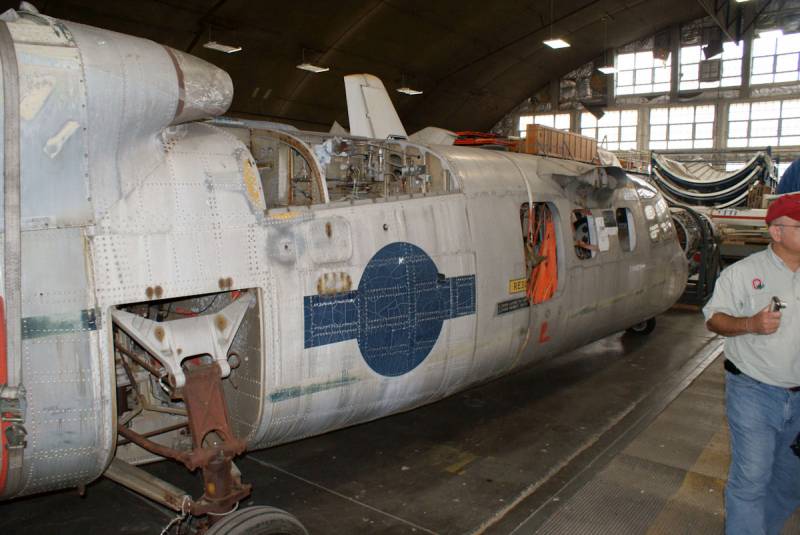
Information